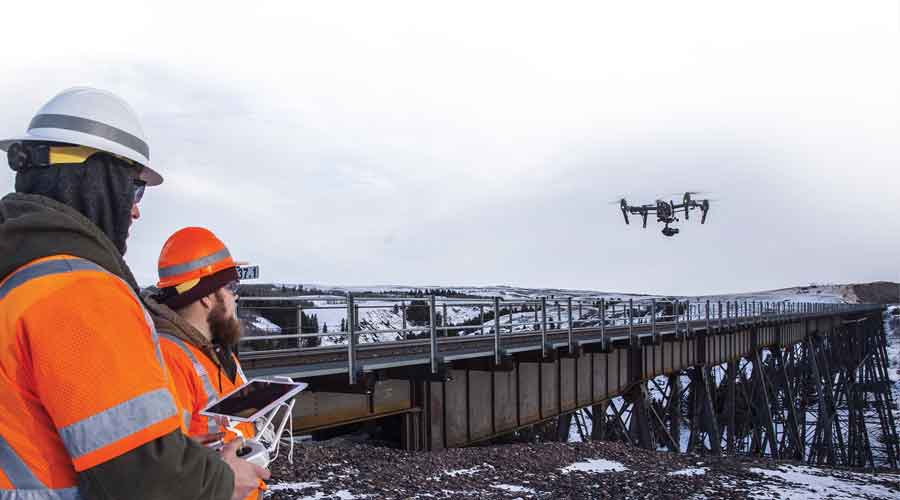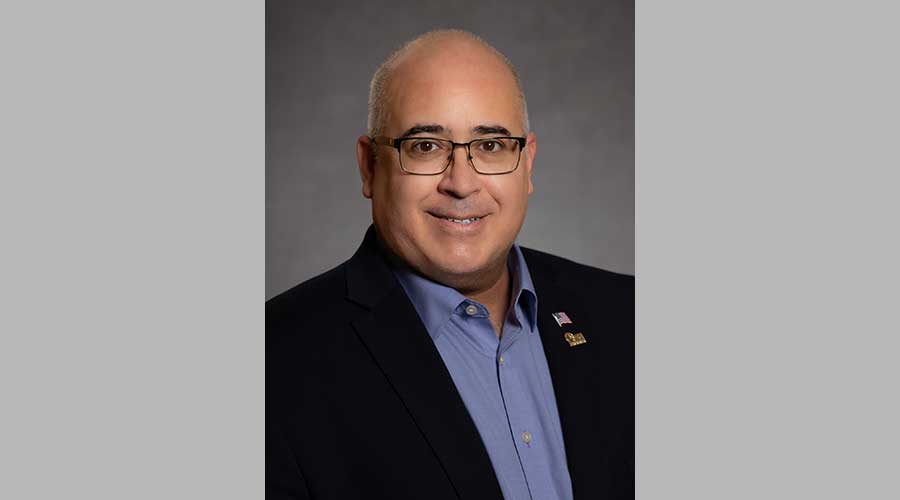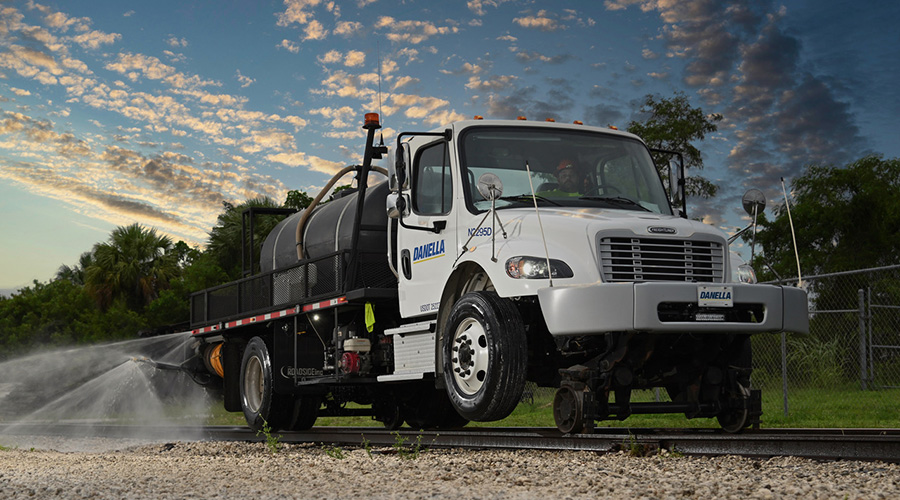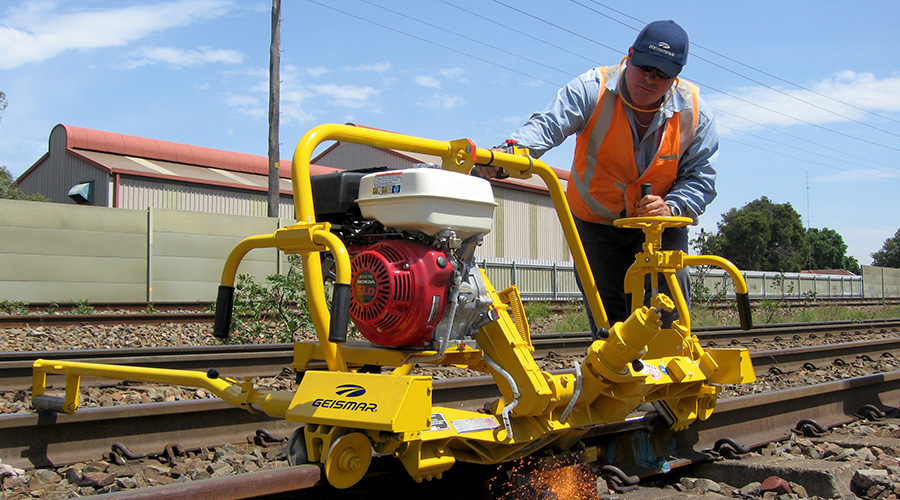Stay updated on news, articles and information for the rail industry
 railPrime
railPrime
March 2020
Rail News: MOW
Short lines gain a new perspective on drone inspection

By Vesna Brajkovic, Associate Editor
Some short lines that became early adopters of basic drone technology to aid in infrastructure inspections have turned to engineering firms with specialized drone operations to harness the full potential of unmanned aerial vehicles (UAVs) for rail bridge inspections.
About four years ago, short lines began purchasing small consumer drones to aid in infrastructure inspection, surveying and corporate photography, says Carl Belke, a rail consultant and the former chief operating officer and president of Western New York and Pennsylvania Railroad (WNYP).
The small railroads embraced drones as a tool with the potential to enable more frequent bridge inspections, especially on structures over water or valleys where traditional inspections can be challenging, costly and time consuming to conduct.
However, some short lines soon realized that to harness the full potential of drones for bridge inspections, drone operations require specialized sensors, super cameras and two- to four-person crews of experienced engineers and drone pilots. All of these factors translated into increased cost, time and resource commitments, Belke explains.
More than that, the drones’ capability to hover close to bridge trusses and piers, collecting thousands of points of data — ranging from images and video to LiDAR and photogrammetric surveys — instantly pushes their operation into the world of Big Data.
From basic tech to specialized operations
By late 2018, short lines began seeking contractors that had dedicated operations and higher quality drone equipment with more sophisticated sensors, as well as the capability to collect and analyze mass amounts of data, says Steven Youschak, executive vice president of ARE Corp. An engineering firm that specializes in UAV technology, ARE manages and inspects about 4,000 short line bridges in the United States.
Since the uptick of interest in drone-supplemented bridge inspections, ARE spent more than $1 million to acquire equipment for its UAV operation.
“That’s what it takes to do this right, and collect the right kind of data to give the railroad client the right deliverable that they can utilize for capital planning and budgeting,” Youschak says.
Contracting out the inspection process also eliminates the need for smaller operations to perform both the inspection and analysis of the data collected during the inspection, since some contractors are able to handle both parts of the process, Belke says.
About two years ago, Belke received the results of a full drone bridge inspection and data analysis from a contractor in less than a month.
“It’s the kind of thing that we couldn’t have put together ourselves in probably a year,” he says.
Supplementing tradition
Traditional bridge inspection methods — which require either an engineer using a rope or harness to suspend under and around the bridge or the deployment of an under-bridge inspection vehicle — require railroads to suspend operations. And to complete these inspections, engineers have to endanger their safety in the railroad right of way.
A drone’s ability to capture images in hard-to-reach places — and at a fraction of the cost of traditional methods and without requiring operation interruptions — make it an attractive tool for inspecting bridge components at challenging crossings, explains Belke. A longtime member of the American Short Line and Regional Railroad Association, he has chaired its engineering committee, and served on the mechanical and technology committees.
For example, on the WNYP and Livonia, Avon & Lakeville Railroad networks, 16 of 275 rail bridges are through-truss structures. In the past, the top chords of those bridges were rarely inspected due to accessibility challenges, Belke says. By deploying drones, crews were able to inspect those components quickly and economically, he adds.
Inspection efficiencies
Drones also enable inspectors to view bridge pins and bearings while under load — a rare point of reference for inspectors, Youschak told Progressive Railroading in an interview last year.
ARE has used drones to inspect Norfolk & Portsmouth Belt Line Railroad Co.’s mechanical lift bridge over the Elizabeth River in Portsmouth, Virginia. ARE deployed drones to visually inspect the 800-foot long, 200-foot high bridge while in operation, a nearly impossible task with other inspection methods.
Drones also enable inspectors to make traditional bridge inspections more efficient.
For example, ARE used drones to supplement inspection of the Ohio River Bridge. Watco Cos. LLC’s almost 4,000-foot long, five-truss rail bridge typically took ARE about a week to complete with two teams of people and a under-bridge inspection truck. That inspection also resulted in shutting down the mainline.
Using drones, inspectors were able to search for and pinpoint areas that need further visual or tactical inspection without shutting down the line. By introducing the technology, ARE was able to cut the week-long inspection process down to about two days, Youschak says.
Class Is explore new vantage points
BNSF Railway Co. also has used drones to gain additional perspectives of its bridges.
The Class I flew three rotations over several dozen bridges in its network to test flight capabilities and develop baseline data models, BNSF Telecommunications Director Todd Graetz said last year in an email to Progressive Railroading.
High-definition images obtained during those flights, including one over a rail bridge 75 feet above the Abo River in New Mexico, provided engineers with a rare view of bridge piers that supplemented traditional bridge inspection.
Despite their advantages, drones don’t yet have the capacity to replace traditional inspection methods entirely, explained Kansas City Southern Assistant VP of Corporate Communications Doniele Carlson in an email.
“While KCS has explored the use of drone technology, at this time, it was determined that drones do not yet provide all of the detailed information required to adequately assess the condition of bridge elements,” Carlson said. “It does have value as a supplemental tool.”
KCS relies on a single under-bridge inspection vehicle to regularly inspect the steel, wood and concrete bridges in its network.
While traditional bridge inspection methods continue to stand the test of time, the unique capabilities of drones provide railroads with an alternative to increase inspection efficiencies and gain rare perspectives of their bridge infrastructure.
Email comments or questions to vesna.brajkovic@tradepress.com.
Keywords
Browse articles on Short lines drone inspection drones unmanned aerial vehicles UAV rail bridge inspections Carl Belke Western New York and Pennsylvania Railroad ASLRRA Steven Youschak ARE Norfolk & Portsmouth Belt Line Railroad Watco BNSF Todd Graetz KCS Doniele Carlson Vesna BrajkovicContact Progressive Railroading editorial staff.


 2025 MOW Spending Report: Passenger-rail programs
2025 MOW Spending Report: Passenger-rail programs
 Gardner steps down as Amtrak CEO
Gardner steps down as Amtrak CEO
 Guest comment: Oliver Wyman’s David Hunt
Guest comment: Oliver Wyman’s David Hunt
 Women of Influence in Rail eBook
Women of Influence in Rail eBook







